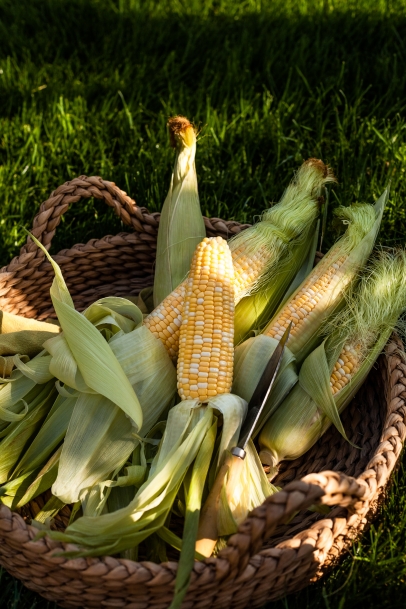Sweet Corn
Following the leaner months of winter and spring, along comes summer bursting at the seams with a robust supply of seasonal fare; juicy berries, fragrant melons, prized tomatoes, peppers, peaches and vibrant greens inspire countless meals. However, there is one particular ingredient that dashes my best-laid dinner plans the moment I spot it at the market: corn on the cob. Succulent, sweet, densely packed kernels that crackle and crunch as you bite into them—fresh sweet corn embodies everything I love about this multifaceted food.
While technically a fruit (according to botanists), sweet corn is more commonly treated as a vegetable and shouldn’t be confused with the aptly named grain corns—their hard, starchy kernels are used for an array of commodities like corn flour, cornmeal and cornstarch, to name a scant few. Sweet corn, as the name would suggest, is cultivated for its sweet, immature “milky” kernels that makes baby corn, frozen kernels and, most notably, corn on the cob, so appealing.
However, sweet corn was not always sweet. First domesticated in southern Mexico 10,000 years ago, early maize was vastly starchier than subsequent sweeter varieties, the latter believed to be the result of a natural genetic mutation dating back to the 18th century. Early corn, or papoon as it was known to the Iroquois, was vital to indigenous populations throughout the Americas and still serves as the backbone of Mexican cuisine today. European settlement and agricultural innovation later transformed this food from a humble grass plant to one of the most globally abundant and economically significant foods. Presently, corn is one of Canada’s most valuable crops with British Columbia yielding an annual eight million kilograms harvested from the Okanagan Valley, Mainland-South Coast and Vancouver Island regions.
While the same can’t be said for grain varieties, very little sweet corn is genetically modified and, fortunately, a growing number of farms are even shifting back to this ancient food’s more modest beginnings. Saanichton’s Silver Rill Corn Farm is one of the top producers of premium organic non-GMO sweet corn and, thankfully, there is no shortage of farm stands across the Island with classics like peaches and cream and super sweet yellow. British Columbia organic grain corn can be found through suppliers like Fieldstone Organics, or by visiting Victoria’s own Maiiz Tortilleria, renowned for their traditionally made tortillas crafted from local heirloom corn.
It’s used for countless recipes, from old-fashioned succotash, elotes and corn bread to contemporary ice creams and mochi. Yet, despite the possibilities, the first sweet corn of the season should really be appreciated in its purest form—boiled or grilled for mere minutes and then glazed in butter and salt. As the summer progresses, I prefer to use it for more involved recipes like pastel de elote, a Mexican sweet corn cake that is actually quite simple to prepare. Dusted in powdered sugar and served with a side of fresh berries and whipped cream, it’s a rustic and casual dessert ideal for summer dining.
For any recipe requiring fresh corn, choose ears that feel firm with tight green husks and silk that is moist, but not rotting. Try not to remove the husk until you’re ready to use it; however, if you must peek for quality assurance purposes, peel a very small section to check for plump kernels near the apex. Because the sugars progressively turn to starch once harvested, consume fresh corn as soon as possible to maximize sweetness.
July marks the onset of harvest here on the Island and, with only a few months to spare, sweet corn season won’t last long—it’s fresh for the picking.





